Scientific classification
Kingdom:
Phylum:
Chordata
Class:
Reptilia
Order:
Testudines
Family:
Cheloniidae
Genus:
Caretta
Species:
C. Caretta
Binomial name (link Wikipedia)




Loggerhead Sea Turtle
La Caouanne
Unechte Karettschildkröte
Tortuga Boba
Onechte Karetschildpad
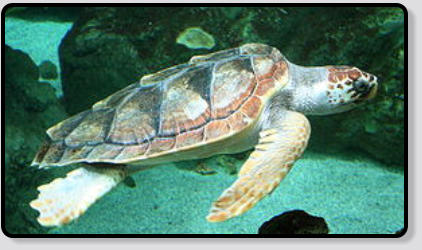
Description
"Loggerhead turtle" redirects here. Loggerhead turtle may also refer to Loggerhead musk turtle.
The loggerhead sea turtle (Caretta caretta), or loggerhead, is an oceanic turtle distributed throughout the world. It is a marine reptile,
belonging to the family Cheloniidae. The average loggerhead measures around 90 cm (35 in) long when fully grown, although larger
specimens of up to 280 cm (110 in) have been discovered. The adult loggerhead sea turtle weighs approximately 135 kg (298 lb), with
the largest specimens weighing in at more than 450 kg (1,000 lb). The skin ranges from yellow to brown in color, and the shell is
typically reddish-brown. No external differences in gender are seen until the turtle becomes an adult, the most obvious difference
being the adult males have thicker tails and shorter plastrons than the females.
The loggerhead sea turtle is found in the Atlantic, Pacific, and Indian Oceans, as well as the Mediterranean Sea. It spends most of its
life in saltwater and estuarine habitats, with females briefly coming ashore to lay eggs. The loggerhead sea turtle has a low
reproductive rate; females lay an average of four egg clutches and then become quiescent, producing no eggs for two to three years.
The loggerhead reaches sexual maturity within 17–33 years and has a lifespan of 47–67 years.
The loggerhead sea turtle is omnivorous, feeding mainly on bottom-dwelling invertebrates. Its large and powerful jaws serve as an
effective tool for dismantling its prey. Young loggerheads are exploited by numerous predators; the eggs are especially vulnerable to
terrestrial organisms. Once the turtles reach adulthood, their formidable size limits predation to large marine animals, such as sharks.

Animalia
Scientific classification
Kingdom:
Phylum:
Chordata
Class:
Reptilia
Order:
Testudines
Family:
Cheloniidae
Genus:
Eretmochelys
Species:
E. imbricata
Binomial name (link Wikipedia)




Hawksbill Sea Turtle
Tortue Imbriquée
Echte Karettschildkröte
Tortuga Carey
Karetschildpad
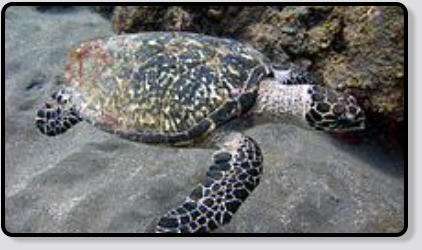
Description
The hawksbill sea turtle (Eretmochelys imbricata) is a critically endangered sea turtle belonging to the family Cheloniidae. It is the only extant
species in the genus Eretmochelys. The species has a worldwide distribution, with Atlantic and Indo-Pacific subspecies—E. i. imbricata and E. i.
bissa, respectively.
The hawksbill's appearance is similar to that of other marine turtles. In general, it has a flattened body shape, a protective carapace, and flipper-
like limbs, adapted for swimming in the open ocean. E. imbricata is easily distinguished from other sea turtles by its sharp, curving beak with
prominent tomium, and the saw-like appearance of its shell margins. Hawksbill shells slightly change colors, depending on water temperature.
While this turtle lives part of its life in the open ocean, it spends more time in shallow lagoons and coral reefs. Human fishing practices threaten
E. imbricata populations with extinction. The World Conservation Union classifies the hawksbill as critically endangered. Hawksbill shells were
the primary source of tortoiseshell material used for decorative purposes. The Convention on International Trade in Endangered Species outlaws
the capture and trade of hawksbill sea turtles and products derived from them.
Adult hawksbill sea turtles have been known to grow up to 1 m (3 ft) in length, weighing around 80 kg (180 lb) on average. The heaviest hawksbill
ever captured was measured to be 127 kg (280 lb). The turtle's shell, or carapace, has an amber background patterned with an irregular
combination of light and dark streaks, with predominantly black and mottled-brown colors radiating to the sides.
Animalia
Scientific classification
Kingdom:
Phylum:
Chordata
Class:
Reptilia
Order:
Testudines
Family:
Cheloniidae
Genus:
Chelonia
Species:
C. mydas
Binomial name (link Wikipedia)




Green Sea Turtle
Tortue Verte
Suppenschildkröte
Tortuga Verde Marina
Groene Zeeschildpad
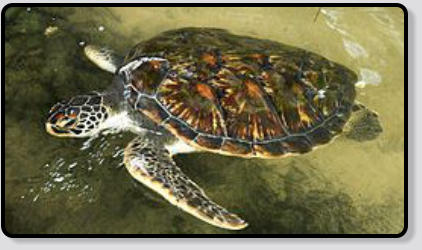
Description
The green sea turtle (Chelonia mydas), also known as the green turtle, black (sea) turtle, or Pacific green turtle, is a large sea turtle of the family
Cheloniidae. This species is named for the green color of its fat, rather than the color of its skin or shell as most people think.[according to
whom?] These turtles' shells are in fact olive to black. It is the only species in the genus Chelonia. Its range extends throughout tropical and
subtropical seas around the world, with two distinct populations in the Atlantic and Pacific Oceans, but also found in the Indian Oceans. The
common name comes from the usually green fat found beneath its carapace.
This sea turtle's dorsoventrally flattened body is covered by a large, teardrop-shaped carapace; it has a pair of large, paddle-like flippers. It is
usually lightly colored, although in the eastern Pacific populations parts of the carapace can be almost black. Unlike other members of its family,
such as the hawksbill sea turtle, C. mydas is mostly herbivorous. The adults usually inhabit shallow lagoons, feeding mostly on various species of
seagrasses. The turtles bite off the tips of the blades of seagrass, which keeps the grass healthy.
Like other sea turtles, green sea turtles migrate long distances between feeding grounds and hatching beaches. Many islands worldwide are
known as Turtle Island due to green sea turtles nesting on their beaches. Females crawl out on beaches, dig nests and lay eggs during the night.
Later, hatchlings emerge and scramble into the water. Those that reach maturity may live to eighty years in the wild.
This turtle is common around the Canary Islands
Animalia
Scientific classification
Kingdom:
Phylum:
Chordata
Class:
Reptilia
Order:
Testudines
Family:
Cheloniidae
Genus:
Lepidochelys
Species:
L. kempii
Binomial name (link Wikipedia)




Kemp's Ridley Sea Turtle
Tortue de Kemp
Atlantik-Bastardschildkröte
Tortuga Lora
Kemp’s Schildpad
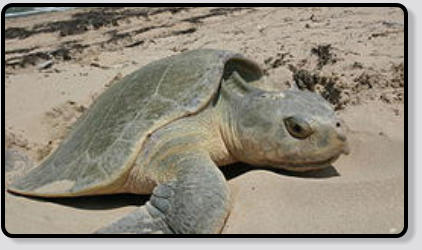
Kemp's ridley sea turtle (Lepidochelys kempii), or the Atlantic ridley sea turtle, is the rarest species of sea turtle and is critically endangered. It is
one of two living species in the genus Lepidochelys (the other one being L. olivacea, the olive ridley sea turtle).
Kemp's ridley is a small sea turtle species, reaching maturity at 58–70 cm (23–28 in) carapace length and weighing only 36–45 kg (79–99
lb).Typical of sea turtles, it has a dorsoventrally depressed body with specially adapted flipper-like front limbs and a beak. Kemp's ridley turtle is
the smallest of the sea turtles, with adults reaching a maximum of 75 cm (30 in) in carapace length and weighing a maximum of 50 kg (110 lb).
The adult has an oval carapace that is almost as wide as it is long and is usually olive-gray in color. The carapace has five pairs of costal scutes.
In each bridge adjoining the plastron to the carapace are four inframarginal scutes, each of which is perforated by a pore. The head has two pairs
of prefrontal scales. Hatchlings are black on both sides. Kemp's ridley has a triangular-shaped head with a somewhat hooked beak with large
crushing surfaces. This turtle is a shallow-water benthic feeder with a diet consisting primarily of crabs.
Kemp's ridley sea turtles generally prefer warm waters, but inhabit waters as far north as New Jersey, They migrate to the Gulf of Mexico and
Florida, where they often inhabit the waters off Louisiana.[citation needed]
Their range includes the Atlantic Ocean and the Gulf of Mexico. Almost all females return each year to a single beach—Rancho Nuevo in the
Mexican state of Tamaulipas—to lay eggs. Some travel as far away as the coast of Ireland, and two individuals managed to journey as far as the
coasts of Devonshire.
Description
Animalia
Scientific classification
Kingdom:
Phylum:
Chordata
Class:
Reptilia
Order:
Testudines
Family:
Dermochelyidae
Genus:
Dermochelys
Species:
D. Coriacea
Binomial name (link Wikipedia)




Leatherback Sea Turtle
Tortue Luth
Lederschildkröte
Tortuga Laúd
Lederschildpad
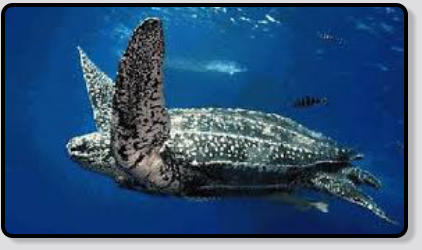
The leatherback sea turtle (Dermochelys coriacea), sometimes called the lute turtle or leathery turtle, is the largest of all living turtles and is the
fourth-heaviest modern reptile behind three crocodilians. It is the only living species in the genus Dermochelys and family Dermochelyidae. It can
easily be differentiated from other modern sea turtles by its lack of a bony shell, hence the name. Instead, its carapace is covered by skin and oily
flesh. Dermochelys is the only extant genus of the family Dermochelyidae.
D. coriacea is the only species in genus Dermochelys. The genus, in turn, contains the only extant member of the family Dermochelyidae.
Domenico Agostino Vandelli named the species first in 1761 as Testudo coriacea after an animal captured at Ostia and donated to the University
of Padua by Pope Clement XIII. In 1816, French zoologist Henri Blainville coined the term Dermochelys. The leatherback was then reclassified
as Dermochelys coriacea. In 1843, the zoologist Leopold Fitzinger put the genus in its own family, Dermochelyidae. In 1884, the American
naturalist Samuel Garman described the species as Sphargis coriacea schlegelii. The two were then united in D. coriacea, with each given
subspecies status as D. c. coriacea and D. c. schlegelii. The subspecies were later labeled invalid synonyms of D. coriacea.
The turtle's common name comes from the leathery texture and appearance of its carapace. Older names include "leathery turtle" and "trunk
turtle".
Description
Animalia




Harry van Goor 2016
source: Wikipedia, the free encyclopedia


Categories: Turtles




